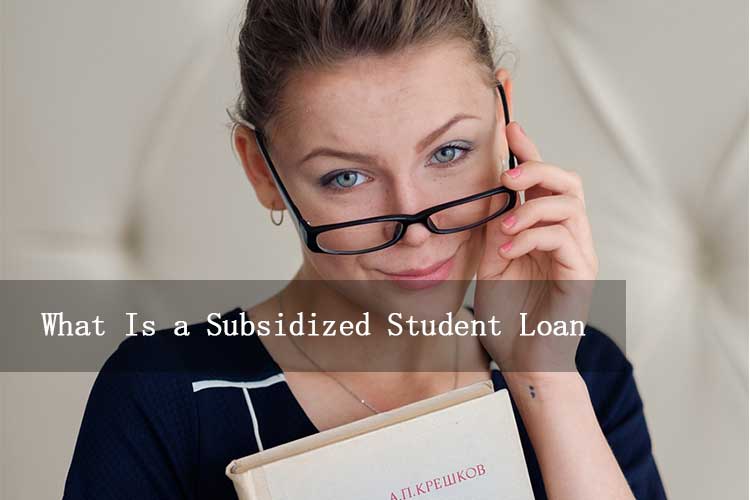
Many students in the U.S. need financial aid to pay for college. This aid can include scholarships, grants, and loans. Federal student loans are a common way to cover education costs. However, it’s crucial to understand the differences between the loan options. Subsidized student loans are particularly beneficial for those who qualify based on financial need. In this guide, we will explain “what is a subsidized student loan,” how it works, who is eligible, and the benefits it offers compared to other loans.
What Is a Subsidized Student Loan?
A subsidized student loan helps undergraduate students who demonstrate financial need. The U.S. Department of Education offers these loans through the Direct Loan Program. One of the main benefits is that the federal government pays the interest while the student is in school, during the six-month grace period after graduation, and during any deferment periods. This feature makes subsidized loans an excellent option for students who want to minimize interest accumulation on their loans.
How Does a Subsidized Student Loan Work?
A subsidized loan stands out from other loan options because the government takes care of the interest under certain conditions. Here’s how it works:
- While you’re in school: If you’re enrolled at least half-time in an accredited institution, the federal government pays the interest on your loan. This helps keep your loan balance from increasing while you concentrate on your education.
- During the grace period: After you graduate or drop below half-time enrollment, you have a six-month grace period before you need to start repaying. The government continues to cover the interest during this time.
- During deferment: If you meet the criteria for deferment (like continuing your education, facing unemployment, or experiencing financial difficulties), the government will also pay the interest, making it easier to manage your loan balance.
This interest subsidy can greatly lower the total cost of borrowing compared to other loans, such as unsubsidized or private loans, where interest starts accumulating as soon as the funds are released.
Eligibility Requirements for Subsidized Student Loans
To be eligible for a subsidized student loan, students need to fulfill certain criteria:
- Financial Need: These loans are granted based on your financial situation. To assess your eligibility, you’ll need to complete the Free Application for Federal Student Aid (FAFSA). The details you provide on the FAFSA help calculate your Expected Family Contribution (EFC), which in turn determines your financial need.
- Undergraduate Status: Subsidized loans are exclusively available to undergraduate students. Those pursuing graduate or professional degrees will need to explore other loan options, like unsubsidized loans or private loans.
- Half-time Enrollment: To qualify for and keep your subsidized loan, you must be enrolled at least half-time in an eligible degree program at an accredited institution.
- Satisfactory Academic Progress: You need to meet your school’s academic standards to continue receiving financial aid, including subsidized loans.
The financial need aspect is a key factor that sets subsidized loans apart from unsubsidized loans, which do not consider financial need.
Subsidized vs. Unsubsidized Loans
Many students have the option to take out unsubsidized loans in addition to subsidized loans, but it’s important to grasp the main differences between the two types.
Subsidized Loans:
- Interest coverage: The government covers the interest while you’re enrolled in school, during the grace period, and if you defer your loans.
- Financial need required: You need to show financial need to be eligible.
- Available to undergraduates only: These loans are exclusively for undergraduate students.
Unsubsidized Loans:
- Interest accrues: You are responsible for all interest from the moment the loan is issued, even while you’re still in school.
- No financial need requirement: Unsubsidized loans are accessible to both undergraduate and graduate students, regardless of financial need.
- Larger loan limits: Students can borrow more each year with unsubsidized loans compared to subsidized ones.
Subsidized loans are generally more beneficial since they help lower your total debt by preventing interest from accumulating while you’re studying. However, they do come with lower borrowing limits compared to unsubsidized loans.
Loan Limits for Subsidized Student Loans
The federal government establishes yearly and total borrowing caps for students using subsidized loans. These caps differ based on the student’s academic year and whether they are considered dependent or independent.
For first-year students, the borrowing limit is set at $3,500. Second-year students can borrow up to $4,500. For those in their third year and beyond, the limit increases to $5,500 each year. Overall, students can borrow a maximum of $23,000 in subsidized loans throughout their undergraduate studies. If your educational expenses surpass these limits, you might need to consider unsubsidized loans or other financial options to cover the extra costs.
Interest Rates for Subsidized Loans
Subsidized loans feature fixed interest rates that the federal government determines each year. Although these rates may vary a bit annually, they tend to be lower compared to private student loan rates.
For the 2023-2024 academic year, undergraduate students will see an interest rate of 5.50% for Direct Subsidized Loans. Since the government pays the interest while you’re enrolled in school, this rate takes effect only after you start repaying the loan following your grace period or deferment.
Repayment Terms for Subsidized Loans
Repaying your subsidized loan is quite similar to handling other federal student loans. The repayment period usually spans from 10 to 25 years, depending on the option you select. Here are a few of the most popular repayment plans:
- Standard Repayment Plan: This plan features fixed monthly payments spread over 10 years.
- Graduated Repayment Plan: With this option, payments start off lower and increase every two years, ensuring the loan is fully paid off within 10 years.
- Income-Driven Repayment Plans: Your monthly payments are determined by your income and family size, and any remaining balance can be forgiven after 20 or 25 years.
These plans provide the flexibility to suit your financial circumstances, and you have the option to change plans if necessary.
Grace Period and Deferment Options
One key benefit of subsidized loans is the six-month grace period that begins after you graduate or reduce your enrollment to less than half-time. During this time, you are not required to make any payments, and importantly, the government covers the interest on your loan. As a result, you have time to search for a job and prepare for repayment without worrying about your loan balance increasing.
Additionally, if you face financial difficulties or plan to continue your education, you can request a deferment. During deferment, the government continues to cover the interest on your subsidized loan. This prevents interest from piling up and helps keep your balance manageable.
Benefits of Subsidized Loans
Choosing a subsidized loan can bring several advantages if you meet the eligibility criteria.
- Interest Savings: One of the biggest perks is the interest subsidy. It stops interest from piling up while you’re in school, making the overall cost of your loan lower compared to unsubsidized or private loans.
- Fixed Interest Rates: Federal student loans, such as subsidized loans, feature fixed interest rates. This ensures consistency in your repayment plan and shields you from unexpected changes in your monthly payments.
- Flexible Repayment Options: Federal loans provide a range of repayment plans, including those based on your income, to help make repayment easier.
- Deferment and Forbearance Options: If you face financial difficulties, federal loans, including subsidized ones, offer options to temporarily pause or lower your payments.
How to Apply for a Subsidized Loan
To obtain a subsidized student loan, you need to fill out the Free Application for Federal Student Aid (FAFSA). This application gathers details about your family’s financial circumstances and helps assess your eligibility for need-based financial assistance, which includes subsidized loans.
Steps to Apply:
- Start by filling out the FAFSA. Go to FAFSA.gov and submit your application online. Be sure to provide all required financial details.
- Check your Student Aid Report (SAR). After submitting the FAFSA, you’ll receive a report showing your Expected Family Contribution (EFC) and aid eligibility.
- Review your financial aid offer. If you’re eligible for subsidized loans, your school will include them in your aid package.
- Accept your loan. You can choose to accept the full subsidized loan or only a portion of it.
Completing the FAFSA early increases your chances of receiving the maximum financial aid available, including subsidized loans.
Conclusion
Subsidized student loans are a fantastic choice for undergraduate students who need financial assistance. These loans come with lower borrowing costs thanks to government-covered interest, making it easier to fund your education. If you’re aiming to keep interest rates low or want flexible repayment plans, subsidized loans can greatly ease the financial strain of attending college.
As you prepare your college budget, be sure to look into all your options and apply for subsidized loans via the FAFSA to maximize their advantages. Knowing what is a subsidized student loan entails and how it functions can empower you to make smart choices regarding your student loan options.



